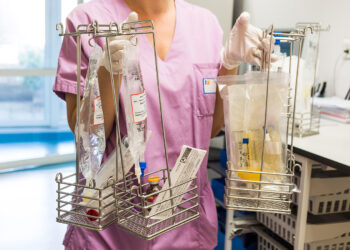[ad_1]
The University of Georgia (UGA) is planning to do something that hasn’t been done in nearly 200 years: Establish a new public medical school in the state.
And with that comes incredible challenges and opportunities. Building a new medical school from the ground up offers the chance to strike out in new ways, build new ideas into an industry known for tradition. But the challenges are equally daunting: You must be able to attract top faculty and a student body that is ready to roll when some bumps along the way.
The UGA has been in a medical school partnership with the Augusta University Medical College of Georgia since 2010 on its Athens, Georgia, campus. But the new UGA school will break off from that union. If everything goes according to plan, there will be two public medical schools in the state.
UGA is set to break ground on its new facility this spring.
Another medical school is sorely needed, said Erica Brownfield, MD, senior associate dean of academic affairs at the UGA Medical School. When it comes to doctors, the state has a supply and demand problem. Georgia ranks eighth in population but 40th in doctors available to care for the 11 million people in the state.
Rural and underserved areas are particularly hard hit, Brownfield said.
The Med School Building Boom
The Peach state isn’t alone in its need for more doctors. It’s estimated there will be a shortage of up to 86,000 physicians in the United States by the year 2036. The population is expected to grow and gray as well. About 34% will be 65 years or older — driving a need for more physicians for seniors who tend to need them most.

So it’s no surprise that new medical schools are being built to train a new generation of doctors.
Some notable others include the Kaiser Permanente Bernard J Tyson School of Medicine in Pasadena, California, and the Tilman J. Fertitta Family College of Medicine at the University of Houston, Houston. Both schools graduated their inaugural classes in 2024.
The Thomas F. Frist, Jr. College of Medicine at Belmont University in Nashville, Tennessee, welcomed its first crop of 50 students in 2024 that will graduate in 2028.
Establishing the new school was a challenge and an opportunity, said Karen Lewis, MD, associate dean for student affairs and belonging and assistant professor of health systems science at a Christian-based Nashville school.
“Building a program from scratch offered an attractive blank slate.” It’s “a chance to create something new while bringing inspiration from other institutions we’ve been at,” she said.
Turning a Vision Into Reality
The experience of the first class begins long before the school doors open.
“We had 3 years of critical development and needed all that time to prepare for our inaugural class. I divide this time into two phases: Pre-students and after students arrive,” Lewis said.
In the pre-student phase, faculty and staff recruits with diverse experiences were integrated into a unified vision for the institution. “This differs from established institutions where new people adapt to existing culture and norms,” she said.
During the years before students are enrolled, the leadership of a new school is busy working to get cleared to open.
Medical schools need to be accredited to be able to operate in the United States. That means they have to demonstrate they’re capable of graduating doctors who competently can care for patients.
- The Liaison Committee on Medical Education accredits schools that award MD degrees.
- The Commission on Osteopathic College Accreditation accredits DO schools.
After an MD school is a candidate for accreditation, it must attain preliminary status before leadership can market their school or begin to admit new students.
UGA went from applicant status to candidate status, “and now we will have our site visit (for preliminary accreditation) in the fall of 2025. If everything goes okay, we will welcome our first class (of 60 students) in August of 2026,” Brownfield said.
Building a Program Brick By Brick
Any new school must establish its identity and mission. UGA’s purpose is to educate students to serve as doctors inside Georgia that will ultimately improve the health of the people of the state, Brownfield said.
“On a larger scale, we are not only training doctors, we are answering a call to serve Georgia’s citizens.,” she said.
At Belmont, Lewis said the medical school’s mission “centers on developing physician leaders, not just physicians –– an important distinction. We emphasize training doctors from diverse backgrounds who understand the value of character and whole person care.”
“Whole person care means seeing beyond clinical factors. Yes, they know your blood pressure
and lab results, but they also understand your family context, challenges, and support systems.
They get to know who you are as much as your health chart,” she said.
Put Together the ‘A’ Team
If you build it, will they come? Lewis said yes.
“A brand-new medical school naturally attracts brilliant, passionate people with innovative ideas
about medical education. The real challenge is bringing these diverse perspectives together to
create a unified vision that shapes everything from curriculum to building design,” she said.
Brownfield said UGA is working to attract new faculty to add to the staff that will transition from the Medical College of Georgia regional campus. One of the biggest draws is that a new school presents a once-in-a-lifetime opportunity to build a school from the ground up, she said.

That includes creating a new curriculum. A traditional curriculum with 2 years of learning basic science in a classroom followed by 2 years of clinical sciences is an old and outdated model, said Lisa Howley, PhD, MEd, senior director of Transforming Medical Education at the Association of American Medical Colleges in Washington, DC.
Curriculum has transitioned to one that’s more student-centered and outcome-based rather than teacher-centered. “We’re integrating foundational sciences with clinical sciences as well,” Howley said.
The Belmont curriculum “is an integrated organ-system approach with an emphasis on problem/case-based learning which equips students for lifelong self-directed learning,” Lewis said. “Service learning, interprofessional education with other health professions, and early clinical preceptorships (supervised training) are key features of our curriculum.”
UGA is still finalizing its curriculum. But Brownfield said, “we absolutely will be having students working with patients — either real, simulated, or both — from day one.”
Get Real About Artificial Intelligence (AI)
AI is here to stay, Lewis said. “It can be a real game changer in a positive way when it comes to healthcare delivery, but just like any new technology, you have to make sure you understand its full capabilities and put the appropriate parameters in place to make sure that it’s used appropriately.”
Either way, AI will be infused into the curriculum, she said. “It’s not possible to prepare physicians for the future and not have AI be a part of it,” she said.
Brownfield said UGA will integrate AI into its curriculum as well, while “being very careful around the ethics and humanity around it.”
“AI can be very instrumental for students to realize where their (learning) gaps are,” she said. For example, AI can help students identify how many cases of upper respiratory illness or diabetes they saw in their third year. It can help them identify diseases they still need to see, she added.
UGA will also explore the use of AI in the admissions process. “It will not replace our process but rather we will pilot its utility in helping us find the best applicants for our school,” Brownfield said.
Create Support Services
Medical students face a lot of stress and burnout is reported by almost half of them. Academics, personal issues, work-life balance, and financial burdens all play a role.
Student wellness is a top priority at medical schools including UGA and Belmont.
Lewis said they’ve created a three-pronged approach at their Nashville school:
- Smaller cohorts: Groups of 16-17 students are paired with dedicated faculty leaders and physical spaces. Students develop relationships that become support systems during a difficult four years of medical school.
- Belmont provides learning specialists who help students understand themselves as learners. Even brilliant students need healthier study habits and self-care practices: Managing sleep, nutrition, exercise, mental health, and spiritual health.
- Wellness is embedded throughout the curriculum. Faculty and staff check in regularly with students.
“We offer wellness activities like yoga, therapy dog visits and massage,” Lewis said. “We encourage students to step away through activities such as painting, walking and friendly house competitions.”
Wanted: Trailblazing Students
“There is a real benefit and excitement to being a part of something new and helping develop it,” so attending a new medical school can be a huge plus for students, said Howley, of the Association of American Medical Colleges.
Jerry Mi decided to take the plunge and attend a brand-new school. The 28-year-old from Rockville, MD, is finishing his first year at Belmont and is the inaugural class president.
The school “really had what I was looking for in a medical school experience,” he said. “Small class size, strong potential for student-faculty relationships, as well as being in a city I really wanted to live in –– those were my highest priorities.”

“The benefits of attending a new medical school have always been the people. For me, it was apparent from day one where faculty members I had never met said, ‘Hey, Jerry, nice to meet you’ without me introducing myself,” he said.
That said, attending a new school isn’t for everyone. The school isn’t eligible to be fully accredited until after the first class graduates. There could be growing pains in a new program and there are no older students to show you the ropes.
The biggest challenge that comes with a new medical school is the sense of ambiguity, Mi said. “Rolling with the punches” is something you’ve got to be comfortable doing. “Many people say they’re okay with that when they apply but then they aren’t actually okay with it,” he said.
But what comes with ambiguity is getting more say as a student in shaping the future of the college, Mi said. “As president, I’ve made more of an impact than friends who have served as presidents at other schools where they have a pre-carved standard for what they can and can’t do.”
[ad_2]
Source link : https://www.medscape.com/viewarticle/designing-new-medical-school-offers-chance-creativity-2025a10007s9?src=rss
Author :
Publish date : 2025-04-01 09:22:00
Copyright for syndicated content belongs to the linked Source.














